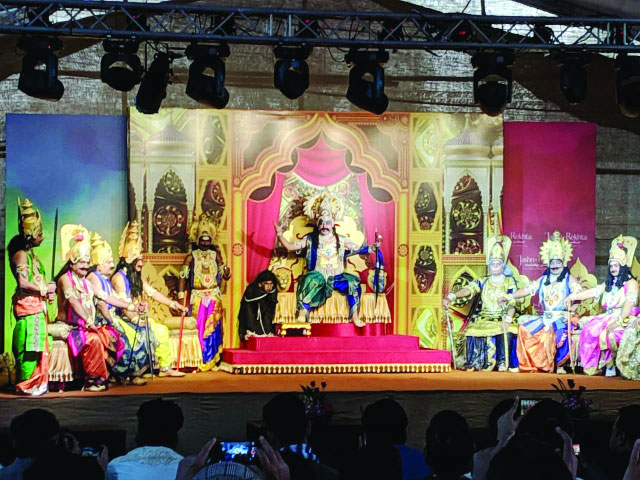For Anil Chawla, directing a Ramayana in Urdu is a representation of what India is all about, discovers Saimi Sattar
In the divisive times that we live in, when Urdu — a language that was born in the country — is considered the exclusive preserve of Muslims, it is only fitting that Jashn-e-Rekhta, the biggest festival in the world celebrating its multi-faceted nature is organised by Sanjiv Saraf, a Hindu. And if that is not enough to cock a snook at all those who abhor the idea of an inclusive India and believe that Maryada Purshottam Rama belongs only to the Hindus, the organisers staged Ram Kahani Urdu Wali over the weekend. As the name suggests, the epic Ramayana was staged in Urdu.
Said director Anil Chawla, who also plays the role of Laxman, “When Rama did not create the divisions, who are we to do so? It is this feeling and tradition of communal amity that we are observing and trying to erase the difference between Hindus and Muslims. This is ultimately the message that there is no reason to fight. We should live together. Both mandir and masjid can co-exist.”
While Chawla discussed the more philosophical aspect of the performance, in the green room make-up artist Shamim Ahmed was engaged with tackling more of the practical — how to make sure that the get-up of Rama and Ravana befit their stature and role. Meanwhile, Hanuman was putting forth his arguments with Ravana while standing next to a table — delivered in chaste Urdu.
The organisers of this Ram Lila are from the Bannu region of southern Khyber Pakhtunkhwa, Pakistan. After the Partition, Bannuchis were allotted property in Faridabad and have a very significant presence in the city. “I watched Ram Lila with my ancestors who were migrants and it is there that I got hooked,” said the 40 something Chawla.
And the tradition is being carried on by the younger generation. “Today, we have the young generation with us and the role of Sita, Rama and Angad are played by actors who are in their 20s. All of them speak chaste Urdu during the play. The remaining cast consists of people in between the ages of 20-50,” he said.
The Ram Lila has been staged for the last 21 years. “For 11 years, we have been performing it in a park of sector 15 of Faridabad. The entire Ramayana is staged over 11 days for two and a half hours each day with about 15,000-20,000 spectators,” he told us.
However at the Jashn-e-Rekhta, the performance was for an hour. “The Rekhta Foundation had asked us to stage the scenes where five main characters — Rama, Lakshman, Sita, Ravana and Hanuman — should be there. So if we would have taken Sita Swayamwar, Hanuman would have been missing. In the Dashrath-Kaikeyi scene, the other characters would go missing.” That’s why they zeroed down on episodes relating to Sita Haran and Ravana-Hanuman Samwad. The latter is when Hanuman goes in search of Sita, plucks fruit from Ashoka Vatika and Meghnad catches hold of him to present him in the court of Ravana.
There are other facets to the play apart from the fact that both Rama and Ravana speak Urdu. “Given the fact that the pronunciation of the language certainly takes more effort, the rehearsals initially were prolonged. We practised regularly for a good one month. However, the cast is now trained and can do with lesser rehearsals,” said Chawla.
Sample the lines which are spoken by Laxman a little before Sita’s abduction, “Jab aap ki zabaan se aise bure khayalat ka izhaar ho raha hai, toh zaruri hai ki hamare liye koi naya bakheda tayyar ho raha hai. Farebi rakshas hain, jaal dhoke ke bichaate hain, roop maya ke ghadi bhar me banate hain (When such bad thoughts are being expressed by you, there is some new mayhem being unleashed on us for sure. The crafty demons want to ensnare us in a web of deceit). Spoken in impeccable Urdu, adequate leverage was given to the sounds from the epiglottis. Moreover, since most people cannot read the Urdu script, the dialogues were written in Devanagari script and given to them. It also had a smattering of verses from Tulsidas, Valmiki as well as other sources.
Moreover, unlike other Ram Lila performances, where the dialogues are recorded or there are people to prompt the actors, here everyone had learnt their lines to perfection. “Even when it is a 20-line shayari, each actor knows it by heart. This is essential to convey the depth of the emotion that the verses are trying to convey. When you see it, you realise how much effort and passion has gone into its staging,” said Chawla. The artistes not only deliver their dialogues but also sing.
The passion is also evident in the fact that none of the actors charge for being a part of the Ram Lila. And this seems to be paying dividends. Last year they became one of the first ones to stage a Ram Lila at Prithvi Theatre, Mumbai, where they were invited. “Our six-hour long performance was much appreciated. The one at Rekhta is a first too,” he said. They’ve also been a part of the Surajkund Mela where this is a highlight. “It is only because of the kripa of Rama ji that we are doing well,” he said.
And if the kripa is maintained over India, a Ram Lila in Urdu would no longer stand out but be as acceptable as the one written by Tulsidas or Valmiki.


























